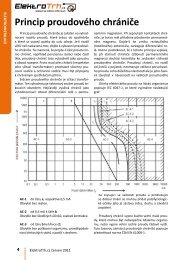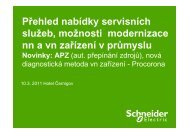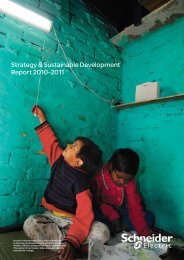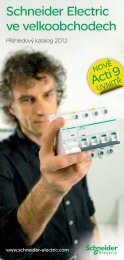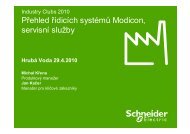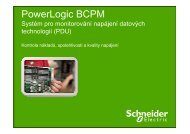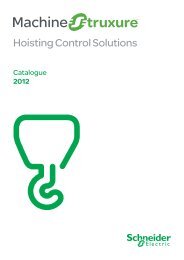2010Annual Report - Schneider Electric CZ, s.r.o.
2010Annual Report - Schneider Electric CZ, s.r.o.
2010Annual Report - Schneider Electric CZ, s.r.o.
You also want an ePaper? Increase the reach of your titles
YUMPU automatically turns print PDFs into web optimized ePapers that Google loves.
1 DESCRIPTION OF THE GROUP, AND ITS STRATEGY, MARKETS AND BUSINESSES<br />
ORGANISATIONAL SIMPLICITY AND EFFICIENCY<br />
36<br />
The gradual roll out of an SAP-based ERP system known as<br />
“bridge” is now focused on back-offi ce functions. After pilot testing<br />
in India, Hungary, Austria, Croatia, Romania, Slovakia and Slovenia,<br />
in 2010 the bridge core system continue to be rolled out in the<br />
French and US plants, as well as in Russia, Argentina and Chile.<br />
The roll out will continue in 2011.<br />
This thinking at Group level was facilitated by the globalisation of<br />
information systems within a single IT function created in 2009 that<br />
has a governance role and provides services internally. This move<br />
towards globalisation mainly involved:<br />
• gradually deploying a single IT Department that serves all<br />
businesses and users within <strong>Schneider</strong> <strong>Electric</strong> in a uniform<br />
manner. To achieve this, the most qualifi ed and competitive<br />
providers – both internal and external – will be used as needed;<br />
• gradually setting up a global IT infrastructure (networks, data<br />
centres, distributed computing and help desk) that is independent<br />
of the various managerial lines and that makes the most of the<br />
Group’s critical size and accumulated experience.<br />
4. 3 Worldwide redeployment of production and supply chain resources<br />
<strong>Schneider</strong> <strong>Electric</strong> has more than 200 production sites and<br />
140 distribution centres around the world for whom customer<br />
satisfaction is the top priority.<br />
While working constantly to improve occupational health and safety<br />
and environmental protection, the Group’s manufacturing policy<br />
aims to fulfi ll fi ve key objectives (listed in order of importance):<br />
1. deliver a level of quality and service that meets or exceeds<br />
customer expectations;<br />
2. achieve competitive product costs and keep increasing<br />
productivity;<br />
3. optimise capital employed in manufacturing operations;<br />
4. limit production sites’ exposure to currency, geopolitical and cost<br />
factor risk;<br />
5. enhance fl exibility and be able to continuously adapt to change.<br />
A number of the production facilities and distribution centres are<br />
dedicated to the global market. The other units are located as close<br />
as possible to their end markets. Although design and/or esthetic<br />
features may be adapted to meet local requirements, <strong>Schneider</strong><br />
<strong>Electric</strong> standardises key components as much as possible. This<br />
global/local approach helps <strong>Schneider</strong> <strong>Electric</strong> maximise economies<br />
of scale and optimise profi tability and service quality.<br />
Drawing on its global scope, the Group has re-balanced and<br />
optimised its manufacturing and supply chain resources. The Group<br />
launched a new stage in its industrial deployment in 2010. As part<br />
of the Group’s new organisation, the Power business production<br />
and supply chain resources have been globalised and combined<br />
under a single organisation, with global operating responsibility.<br />
Previously, these resources were organised by region and reported<br />
to the various Operating Divisions.<br />
2010 REGISTRATION DOCUMENT SCHNEIDER ELECTRIC<br />
In Western Europe, the United States, Japan and Australia,<br />
rightsizing plans continued to be deployed with a focus on<br />
specialising production and supply chain units and reducing the<br />
number of sites.<br />
Continuous improvement on a global scale<br />
At the same time, an industrial excellence program called<br />
<strong>Schneider</strong> Production System (SPS) has been rolled out in all<br />
plants to substantially and continuously improve service quality<br />
and productivity. The program also takes environmental criteria<br />
into account. Based on a lean manufacturing approach, SPS<br />
is supported by the extension of Six Sigma and Quality and<br />
Value Analysis programs across the Group. By deploying these<br />
optimisation methods globally and sharing best practices, the<br />
Group intends to lift the operational performance of all its plants to<br />
the same high standard.<br />
<strong>Schneider</strong> <strong>Electric</strong>’s plants and products comply with increasingly<br />
extensive and stringent European regulations and with international<br />
standards governing environmental protection in all host countries.<br />
In many cases, the Group anticipates future standards. In 1992,<br />
<strong>Schneider</strong> <strong>Electric</strong> defi ned a formal environmental policy, which was<br />
revised in 2004 to take account of changes both inside and outside<br />
the Group. This policy is designed to improve production processes,<br />
promote eco-design, integrate customer expectations into the<br />
Group’s environmental protection approach and raise awareness<br />
among all employees and partners about environmental protection<br />
and energy effi ciency. In order to limit risks related to the environment<br />
generally, the Group has implemented an ISO 14001-compliant<br />
process to continuously improve the environmental performance of<br />
its plants and supply chain centres.




